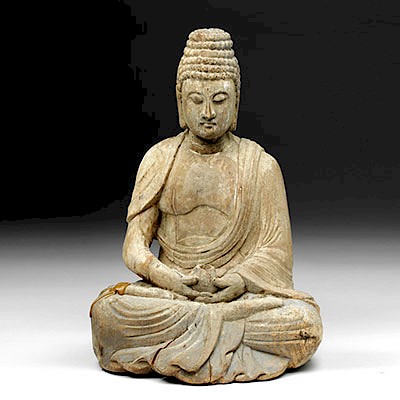19th C. Mexican Polychrome Wood Santo - Saint Blaise
Lot 149
About Seller
Artemis Gallery
686 S Taylor Ave, Ste 106
Louisville, CO 80027
United States
Selling antiquities, ancient and ethnographic art online since 1993, Artemis Gallery specializes in Classical Antiquities (Egyptian, Greek, Roman, Near Eastern), Asian, Pre-Columbian, African / Tribal / Oceanographic art. Our extensive inventory includes pottery, stone, metal, wood, glass and textil...Read more
Categories
Estimate:
$4,000 - $5,000
Absentee vs Live bid
Two ways to bid:
- Leave a max absentee bid and the platform will bid on your behalf up to your maximum bid during the live auction.
- Bid live during the auction and your bids will be submitted real-time to the auctioneer.
Bid Increments
| Price | Bid Increment |
|---|---|
| $0 | $25 |
| $300 | $50 |
| $1,000 | $100 |
| $2,000 | $250 |
| $5,000 | $500 |
| $10,000 | $1,000 |
| $20,000 | $2,500 |
| $50,000 | $5,000 |
| $100,000 | $10,000 |
| $200,000 | $20,000 |
About Auction
By Artemis Gallery
Jun 7, 2018
Set Reminder
2018-06-07 09:00:00
2018-06-07 09:00:00
America/New_York
Bidsquare
Bidsquare : Clearance Sale - Ancient / Ethnographic Art
https://www.bidsquare.com/auctions/artemis-gallery/clearance-sale---ancient-ethnographic-art-3264
Looking for a bargain on authentic ancient and ethnographic art? These lots are going, going, gone! Artemis Gallery info@artemisgallery.com
Looking for a bargain on authentic ancient and ethnographic art? These lots are going, going, gone! Artemis Gallery info@artemisgallery.com
- Lot Description
New World, Spanish Colonial, Mexico, ca. 19th century CE. A hand-carved, painted wood Santo of San Blas, a saint born in Armenia and devoted to a life in medicine until his election to the episcopal diocese of Sebaste. He then withdrew to a cave on Mt Argeus to cure sick people and animals who came to be healed and blessed. The santero depicted him in his traditional manner, dressed as a bishop w/ a silver handled crosier incised with stars accompanied by sheep, alluding to his secluded life in the woods. Size: 9.5" L x 13" W x 34.25" H (24.1 cm x 33 cm x 87 cm)
Christians were persecuted by Agricola, governor of Cappadocia, during the reign of Emperor Licinius. San Blas was discovered during this time when hunters searching for wild beasts for arena games found a group of tigers, lions, and wolves at the mouth of his cave. Saint Blaise was soon arrested and given opportunities to renounce his religious beliefs, but being devout, he consistently refused. After enduring a grueling torture treatment, Blaise was tossed into a lake, but he proceeded to walk on water. He invited his tormenters to follow suit, but the pagans failed and drowned. Most sources agree that he was martyred by having his flesh ripped off with wool combs; hence, his red blood-covered hands in this depiction. Saint Blaise is thus the patron saint of wool combers as well as the patron saint of physicians and one of the Fourteen Holy Helpers.
Santos played an important role in bringing the Catholic Church to the New World with the Spanish colonists. These religious figures were hand-carved and often furnished with crowns, jewels, and other accessories, usually funded by religious devotees, and were used as icons to explain the major figures - Mary, Christ, and the saints - to new, indigenous converts. Likewise, they served as a connection to the Old World for Spanish colonists far from home. Many of them were lovingly cared for over the years, with repairs and paint added as they aged, and played an active part for a long time in the religious life of their communities. Oftentimes regarded as quite valuable and expensive, the creation of Santos was usually funded by religious devotees.
Provenance: Ex-Francis & Lilly Robicsek Collection, Charlotte, NC
All items legal to buy/sell under U.S. Statute covering cultural patrimony Code 2600, CHAPTER 14, and are guaranteed to be as described or your money back.
A Certificate of Authenticity will accompany all winning bids.
We ship worldwide and handle all shipping in-house for your convenience.
#120610Age crack from neck down to integral base as shown. Expected surface wear with nicks, losses to pigment, and gold leaf. Silver handle of crosier shows expected tarnish. Animals are not attached to pedestal.Condition
- Shipping Info
-
All shipping is handled in-house for your convenience. Your invoice from Artemis Gallery will include shipping calculation instructions. If in doubt, please inquire BEFORE bidding for estimated shipping costs for individual items.
-
- Buyer's Premium



 EUR
EUR CAD
CAD AUD
AUD GBP
GBP MXN
MXN HKD
HKD CNY
CNY MYR
MYR SEK
SEK SGD
SGD CHF
CHF THB
THB


















